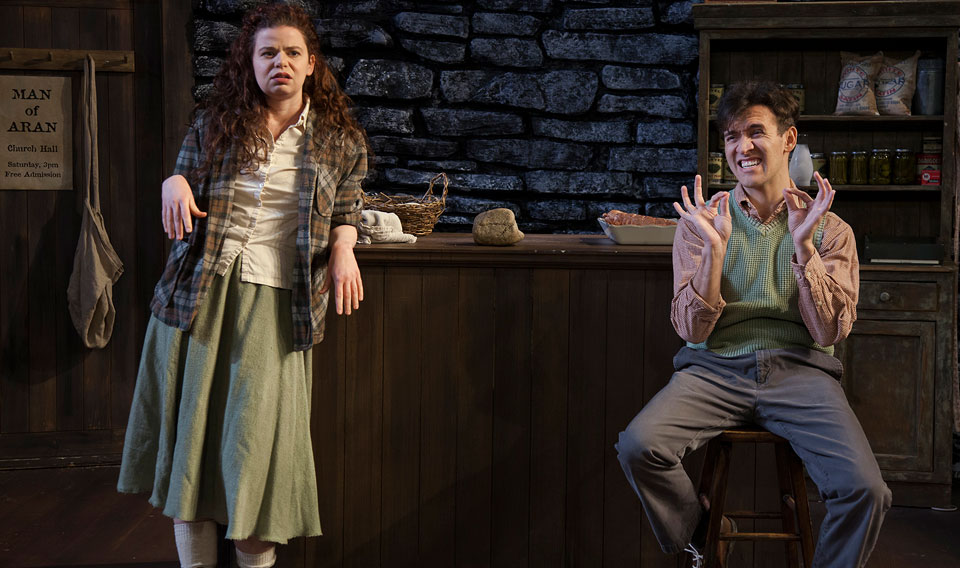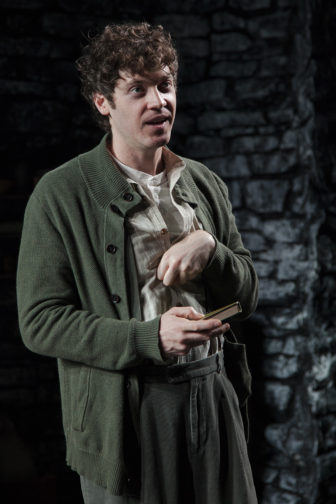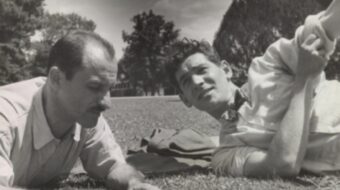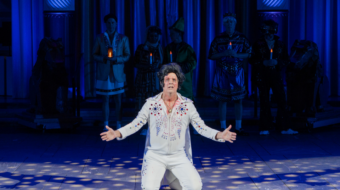
GLENDALE, Calif.—Three tiny outcroppings of rock called the Aran Islands appear on the map as if guarding the entrance to Galway Bay on the rugged Atlantic coast of Ireland. Formed of barren limestone, they are home to a small, ingrown community of desperately underemployed farmers and fishermen who seem to have little more to do than pick on one another, with their famous Irish gift of verbal invention, out of frustration at the geographical hand fate has dealt them.
In The Cripple of Inishmaan, dating from 1996, playwright Martin McDonagh spins a tragi-comic yarn woven from their sad dissatisfactions. The play, now on view at the Antaeus Theatre here, is one of a trilogy about the islands that includes The Lieutenant of Inishmore and The Banshees of Inisheer. Another of McDonagh’s frequently staged plays is The Beauty Queen of Leenane, which is also one of a trilogy including A Skull in Connemara and The Lonesome West. He frequently draws on his juicy Irish heritage, though he was born across the Irish Sea in Britain.
These works are fully in the spirit of the masterful Irish playwright of a century ago, John Millington Synge, whose Riders to the Sea also uses the rough western counties as his setting, with a strong emphasis on regional dialect (I once saw a classic production of it in Dublin and barely understood a word).
A cast of nine characters centers around young Billy Claven (Matthew Grondin), orphaned and crippled since birth, and raised by a pair of spinster sisters, his “aunties” Kate (Kitty Swink) and Eileen (Julia Fletcher). In keeping with Antaeus tradition, its plays are “partner cast.” On February 17, when I caught the show, I saw the “Fripple Frapples,” but at other performances you may see “The Yalla-Mallows,” named for the junk candies the sisters carry in their sorry little grocery shop that centers the play. The company website indicates which cast is appearing on which dates. In an important London revival of the play in 2013 that traveled the following year to New York, Harry Potter’s world-famous Daniel Radcliffe played the role of Billy to wide acclaim.
The ensemble also includes the claustrophobic town’s gossip, the talkaholic Johnnypateenmike (JD Cullum), who snoops about for any news that might conceivably earn him a bite of food from his novelty-hungry neighbors; the role clearly has its roots in the old function of the town crier. There’s a sister and brother couple, the vulgar and even violent but spunky Helen (Abby Wilde) and Bartley (Joey Millin), who is considered the village idiot. And a clearly emotionally troubled seaman, Babbybobby (Seamus Dever), who lost his wife to TB. Rounding out the cast are the kind-hearted Doctor McSharry (Phil Proctor) and Johnnypateenmike’s mother Mammy (Anne Gee Byrd in both partner casts), who enjoys her daily tippling. Steven Robman directs—no small feat being the challenge of the rural Irish accent. Lauren Lovett served as dialect coach.
Almost without exception, McDonagh’s characters are highly flawed—“damaged” might be the more contemporary term—given to acts and words of cruelty. Obviously Billy is not the only “cripple” in the play: His fellow residents of Inishmaan are graphically rendered psychological outsiders. In that sense, the playwright poses an astutely aggressive counter-proposition to the romanticized version of Irish life and poverty playgoers and moviegoers are often exposed to. One subject that gets mentioned more than once in rather explicit detail is priestly abuse of children, a topic not so much in the public discourse when the play was written. Perhaps the play had a role in opening up that inquiry.
McDonagh also has an active career as a film writer and director—Seven Psychopaths, the short Six Shooter, In Bruges, and Three Billboards Outside Ebbing, Missouri.
The play takes place in 1934 if the program is to be believed. Johnnypateenmike at one point reads a newspaper and comments not disapprovingly on Hitler in Germany. For what it’s worth, however, this is historically slightly inaccurate. A critical plot vector is the arrival on Inishmore, a neighboring Aran island, of documentary film director Robert J. Flaherty’s crew, beginning work on his seminal production Man of Aran, which was released in 1934. The actual shooting took place between 1931 and 1933. The physically challenged Billy escapes across the water to see if he can find a role in the film, as the documentary will be hiring a number of locals.
If McDonagh’s play is an artistically, absurdly valid collapsing of vivid, exaggeratedly ludic personalities into one small cast, it bears stating that Flaherty’s film also took numerous liberties with “verité.” He created a screen family out of unrelated villagers, he shot the film as a silent and added sound only later, and his thrilling scenes of man against shark were entirely anachronistic: By the early 1930s shark fishing had disappeared from the islands for such a long time that Flaherty had to hire fishermen from abroad to teach the Aran sailors. With little narrative storyline, the 77-minute film is a landmark nevertheless as a poetic, scenic vision of life’s hardships on and at the edge of the sea.
In any case, Billy did not get a part. To play the village “cripple,” according to the play, Flaherty found a fully-abled young man from Fort Lauderdale. I don’t know if this is true or not, but either way McDonagh as early as 1996 was making a strong, pointed observation about representation of the disabled.

Billy did not get the part, but unexpectedly he did manage to be offered the opportunity to take a screen test in Hollywood for possible future roles. The scene of his lonely exile in Los Angeles is poignant: He appears to be alone and abandoned in a sad rooming house seemingly even more full of despair than his home on Inishmaan.
A high point of the play is the first local showing of Man of Aran in a church social hall, including actual clips from the film. Amusingly, the townspeople are more interested in continuing their gossip than reverently watching Flaherty’s masterpiece.
Set designer John Iacovelli gives us a dark, stony interior. Costume designer Garry D. Lennon recreates a poverty-stricken Depression-era village with only a sweater or skirt to suggest a 1930s sense of style. Co-lighting and projection designers are Kaitlyn Pietras and Jason H. Thompson, sound designer is Jeff Gardner, and props designer is Erin Walley.
I found myself not understanding every word uttered, but after a while not caring, for McDonagh clearly finds joy purely in the gift of language itself. It’s a great contemporary play that is both fun to watch and emotionally affecting. I’d like to think we have moved past the bullying, the insults, the put-downs, the violence, but alas, we have not. The story speaks to us with a sure confidence that what it has to say matters.
Another striking work of art set in the islands is the Opéra d’Aran composed by the French vocalist Gilbert Bécaud, which can be viewed and heard in its entirety on YouTube.
The Cripple of Inishmaan continues at the Antaeus Theatre Company through March 11 with performances on Fri. and Sat. at 8 pm, Sun. at 2 pm and Mon. at 8 pm. The Kiki & David Gindler Performing Arts Center is located at 110 East Broadway, Glendale 91205. Tickets may be purchased by calling (818) 506-1983 or at the website www.Antaeus.org.










